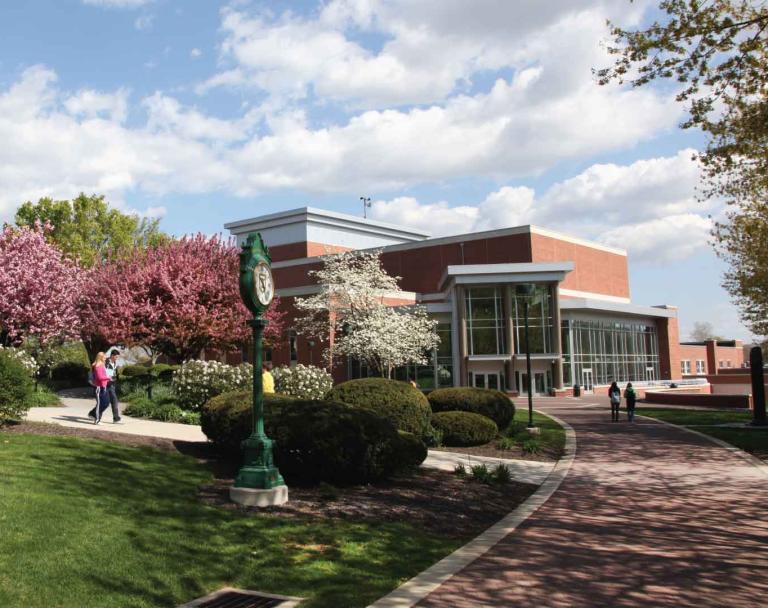Keely Bluett

Student Explores How Environmental Hazards and Justice Differ Between Racial Demographics
York College of Pennsylvania senior Keely Bluett combined her interest in history and geography with environmental sustainability when she undertook the research project, “Where Do the Children Play?”: Comparing Environmental Justice Between the Warren County Hazardous Waste Landfill and the Love Canal Crisis.”
A commuter who lives in Red Lion, Pennsylvania, Keely is a Public History major with a minor in Fine Arts and a constellation in Environmental Sustainability. Her project was displayed at the annual York College Multidisciplinary Undergraduate Research Showcase, sponsored by the Office of the Provost.
How did you choose the topic?
Since coming to York College, “I have learned more about the effects of climate change, climate justice, and human relationships with the environment,” says Keely. “I combined these focuses with my interest in social history, specifically for minority and activist groups. I learned about the events at Warren County and Love Canal while taking a Sustainable Engineering class in the fall of 2020. Discovering more about how the environment is treated in society and the direct connection between environmental and human rights led me to focus on environmental justice.”
What did the research involve?
“To conduct my research, I first started to learn about the modern environmental movement of the 1960s to see how environmental legislation and activism developed before the emergence of the environmental justice movement,” Keely says.
Then her focus changed. “My research focus shifted to environmental justice, specifically through two case studies that are known for launching the movement. These case studies are Warren County, North Carolina, where the state was forcing a PCB (an extremely toxic chemical) landfill into a predominantly Black community, and Love Canal, New York, where a school and neighborhood discovered their community was built on a covered-up toxic waste dump and the chemicals were causing harmful health effects.”
The Love Canal crisis was announced shortly before the implementation of the PCB landfill in Warren County. Based on the safety concerns and terrifying health effects shown by Love Canal, Warren County feared having a PCB landfill in their community. Keely analyzed a primary source base that included local newspaper articles, nationally known newspapers, government documents and legislation, photographs, and other documents from activist groups that provided insight into the conflict of Warren County and Love Canal. “I compared the events of Warren County and Love Canal to see how environmental hazards and justice differ between racial demographics, as well as the future of environmental justice and disproportionate environmental conditions.”
Surprises and challenges
“Exploring the primary sources was a constant surprise,” Keely says, “because my understanding of life and society during the 1970s-1980s within the specific locations of my case studies expanded.” She saw how the media was perceived by people at a different point in history and how it shaped their lives and perspectives. She adds, “History is compared to the present, and you see many repeating qualities and lessons that have not been learned yet.” Photographs provided a lot of information, because their visual power of telling a story is great. “I saw photos of protests that took place in Warren County, which included citizens lying on the ground to prevent trucks carrying PCB waste to the landfill.” Visual narrative helped Keely understand what occurred.
Keely says it was challenging finding appropriate primary material that supported her research and also provided a new perspective to the topic. “It takes time to sift through digital archives and find what is important.”
However, she says, “I'm proud of discovering a new historical event, one that I had no previous knowledge of, and immersing myself into learning all I can about it. As well as providing some new insight on the events. I am also proud about combining my academic and personal interests into a research project that excites me and is, hopefully, found intriguing to others. The role of environmental justice in history and today is important to understand and acknowledge in order to encourage a more equitable, safe, and prosperous future for all races and demographics.”
Keely says “experiencing the research process and developing my own thesis and analysis as an undergraduate will better help any future research I conduct. The research process helps build critical thinking skills, better communication/writing, and experiential learning through some trial-and-error processes.”
Faculty support
Keely’s professors were very supportive. “Dr. [Peter] Levy helped guide me in finding my perspective on environmental justice and the environmental movement as a whole,” she says. “He provided me with sources to look into and historical actors/events to research. Dr. [Kay] McAdams and Dr. [Corey] Brooks supported my research topic, ideas, and process throughout their courses, including Methods and Theory of History and Senior History Seminar. Other Professors in Geography and Environmental Sustainability helped me expand my knowledge around environmental affairs in order for me to combine those topics into my Public History major,” she says.
Dr. Brooks praised her work and says, “Keely’s research offers a sophisticated and thoughtful analysis of the origins of the environmental justice movement built on careful and rigorous research into primary historical sources that reveal the racial politics that shaped the protests that formed this important social movement.”

